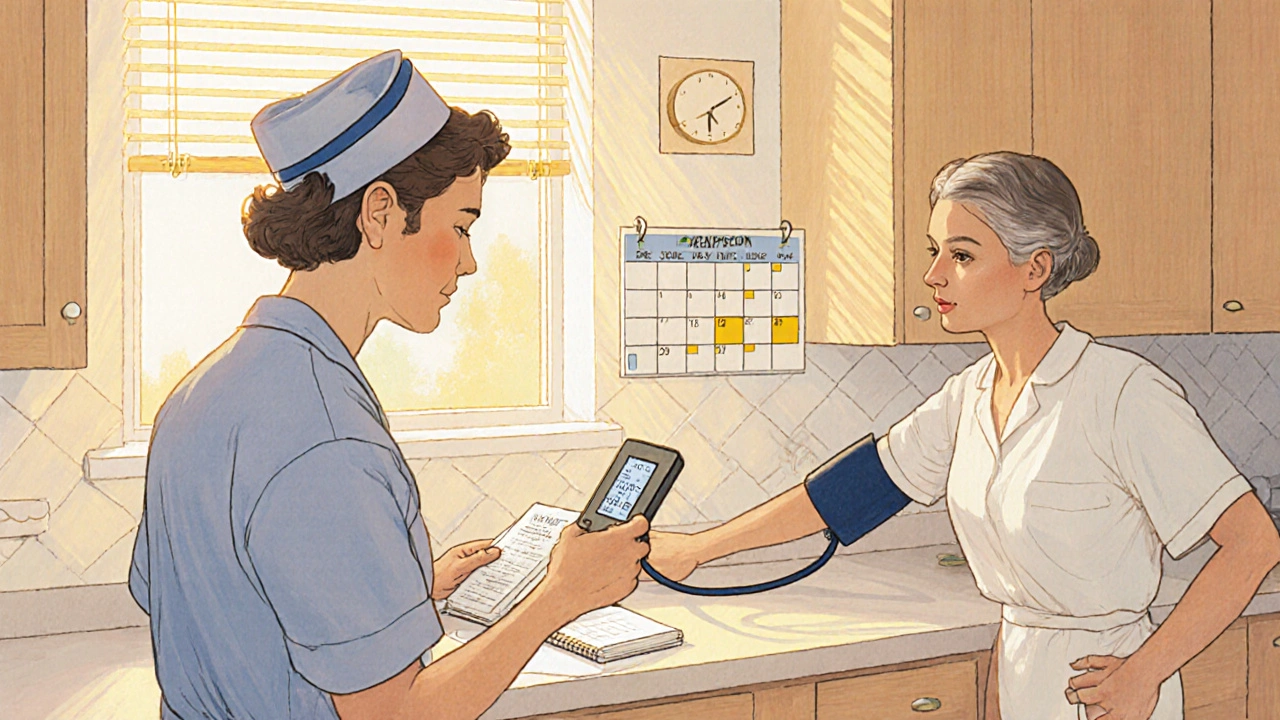Ramipril (Altace) vs. Alternative Blood Pressure Drugs - Comprehensive Comparison
 Oct, 21 2025
Oct, 21 2025
Blood Pressure Medication Decision Tool
Select Your Health Considerations
If you’ve been prescribed Ramipril (brand name Altace) and wonder whether another pill might work better, you’re not alone. Millions of Australians manage hypertension every day, and the market is packed with drugs that claim similar benefits but differ in side‑effects, dosing, and cost. This guide breaks down how Ramipril stacks up against its most common alternatives so you can decide what’s right for your heart and kidneys.
What is Ramipril (Altace) and how does it work?
Ramipril is an angiotensin‑converting enzyme (ACE) inhibitor used to lower blood pressure, improve survival after a heart attack, and protect kidney function in people with diabetes. It was first approved in 1991 and sold under the brand name Altace. By blocking the enzyme that converts angiotensin I to the vasoconstrictor angiotensin II, Ramipril relaxes blood vessels, reduces aldosterone secretion, and lowers the workload on the heart.
Typical starting dose for adults is 2.5 mg once daily, titrated up to 10 mg as needed. It’s taken as a plain tablet, usually in the morning, and can be combined with a diuretic for added effect.
Why consider alternatives?
Even though Ramipril works well for many, a few reasons push patients to look elsewhere:
- Persistent cough - a dry, tick‑like cough occurs in up to 10 % of ACE‑inhibitor users.
- Elevated potassium - some people develop hyperkalaemia, especially those with kidney disease.
- Cost - generic Ramipril is cheap, but insurance formularies sometimes favor other agents.
- Drug interactions - certain antibiotics, NSAIDs, or potassium‑saving diuretics magnify side‑effects.
- Physician preference - specialists may favour agents with specific trial data for heart failure or post‑MI patients.
When any of these issues arise, doctors typically consider other ACE inhibitors, ARBs (angiotensin‑II‑receptor blockers), or completely different drug classes.
ACE inhibitors: the main family
Ramipril belongs to a larger class called ACE inhibitors. All members share the same basic mechanism but differ in potency, half‑life, and side‑effect profile.
Lisinopril is a long‑acting ACE inhibitor approved in 1993. It’s taken once daily, usually 10-40 mg, and is known for a relatively flat dose‑response curve.
Enalapril is another popular ACE inhibitor, often prescribed at 5-20 mg twice daily. It has a slightly shorter half‑life than Ramipril, so some clinicians split the dose.
Benazepril is marketed in Australia as a once‑daily tablet (5-20 mg). It’s metabolized to an active form with a half‑life similar to Ramipril’s.
All three are effective at lowering systolic pressure by 8‑12 mm Hg on average, and each carries the classic ACE‑inhibitor cough risk.
ARBs: the common substitute
If the cough is a deal‑breaker, many doctors switch to an ARB, which blocks the same pathway downstream of the enzyme.
Losartan was the first ARB on the market (1995). Typical dosing is 50‑100 mg once daily, with a half‑life of about 2 hours but an active metabolite that extends the effect.
Valsartan entered the Australian market in 1998. It’s dosed at 80‑320 mg daily, often combined with a diuretic for hypertension.
ARBs generally cause fewer coughs and less angio‑edema, but they can raise potassium levels and may be slightly more expensive than generic ACE inhibitors.

Other classes used with or instead of ACE inhibitors
Sometimes patients need a completely different mechanism, either because of contraindications or to achieve better BP control.
Hydrochlorothiazide (HCTZ) is a thiazide diuretic that reduces fluid volume. It’s typically 12.5‑25 mg once daily and works well in combination with ACE inhibitors or ARBs.
Amlodipine is a calcium‑channel blocker that relaxes arterial smooth muscle. Doses range from 2.5‑10 mg daily, and it’s often added when BP remains high despite ACE‑inhibitor therapy.
These agents address different physiological pathways - volume overload versus vascular tone - and are useful when single‑drug therapy isn’t enough.
Side‑effect profile comparison
| Drug | Class | Typical Dose Range | Common Side‑effects | Average Cost (AU$) per month* |
|---|---|---|---|---|
| Ramipril | ACE inhibitor | 2.5‑10 mg once daily | Cough, hyperkalaemia, dizziness | 12‑20 |
| Lisinopril | ACE inhibitor | 10‑40 mg once daily | Cough, rash, elevated creatinine | 10‑18 |
| Enalapril | ACE inhibitor | 5‑20 mg twice daily | Cough, fatigue, taste changes | 13‑22 |
| Losartan | ARB | 50‑100 mg once daily | Dizziness, hyperkalaemia, rare cough | 15‑25 |
| Hydrochlorothiazide | Thiazide diuretic | 12.5‑25 mg once daily | Increased urination, low potassium, gout flare | 8‑12 |
*Costs are based on the Australian Pharmaceutical Benefits Scheme (PBS) prices for 2025 and may vary with private scripts.
Cost and availability snapshot (2025)
Ramipril remains one of the most affordable ACE inhibitors because it’s fully listed on the PBS. Lisinopril and Enalapril are similarly priced, while brand‑name versions of ARBs (e.g., Cozaar® for Losartan) sit a few dollars higher. Diuretics like HCTZ are the cheapest option, often under $10 per month.
All the drugs listed above are widely available in Australian pharmacies, both as single‑pill prescriptions and in fixed‑dose combination packs (e.g., Ramipril + HCTZ).

How to decide which drug fits you?
Choosing the right medication isn’t just about the numbers on the label. Consider these practical questions:
- Do you have a chronic cough? If yes, an ARB or a different class may be better.
- How are your kidneys? Elevated creatinine or a history of renal artery stenosis pushes clinicians toward lower‑dose ACE‑inhibitors or ARBs with close labs.
- Is potassium a concern? People taking potassium‑rich diets or supplements should avoid high‑potassium‑raising agents.
- What does your insurance cover? PBS listings often dictate the out‑of‑pocket cost.
- Are you on other meds? ACE inhibitors can interact with NSAIDs and certain antibiotics; ARBs have fewer such interactions.
Write down answers to these questions before your next GP visit. That way you can have a focused conversation and avoid a trial‑and‑error approach.
Switching safely: what to expect
If you and your doctor decide to move away from Ramipril, the transition is usually straightforward:
- Stop Ramipril on the day you start the new drug-no taper needed for most ACE inhibitors.
- Schedule a BP check within 1‑2 weeks to confirm the new medication is controlling pressure.
- Blood tests (creatinine, potassium) should be repeated 1‑2 weeks after the switch, then monthly for the first three months.
- Watch for new side‑effects: a sudden drop in BP can cause dizziness, while an ARB may cause mild headache.
- If you’re adding a diuretic, start at the lowest dose to avoid excessive fluid loss.
Most patients feel fine after the first month. If problems persist, your doctor may fine‑tune the dose or try a different combination.
Bottom line
Ramipril is a solid, cost‑effective first line for hypertension and heart‑failure patients. However, the cough, potassium rise, or drug‑interaction concerns can make alternatives like Lisinopril, Enalapril, Losartan, or even a diuretic‑based regimen a better fit. Use the comparison table to weigh efficacy, side‑effects, and price, then discuss your preferences with your prescriber.
Can I take Ramipril if I’m pregnant?
No. ACE inhibitors, including Ramipril, are linked to birth defects and fetal kidney problems. Doctors usually switch pregnant patients to labetalol or methyldopa.
How long does the Ramipril cough usually last?
If the cough is drug‑related, it often starts within weeks of starting therapy and may persist as long as the medication is taken. Switching to an ARB typically resolves it within a few days.
Is it safe to combine Ramipril with a diuretic?
Yes, many doctors prescribe a fixed‑dose combo of Ramipril + Hydrochlorothiazide. It enhances BP control but requires monitoring of potassium and kidney function.
What should I do if I miss a dose?
Take the missed tablet as soon as you remember, unless it’s almost time for the next dose. In that case, skip the missed one and continue with your regular schedule-don’t double up.
Are there natural ways to reduce the Ramipril cough?
Staying well hydrated and using honey‑lemon tea can soothe mild irritation, but the most reliable fix is switching to an ARB or a different ACE inhibitor under medical advice.

Sakib Shaikh
October 21, 2025 AT 14:33Listen up, folks: the Ramipril cough isn’t just a minor irritant, it’s a full‑blown drama that can ruin your evenings. I’ve read every trial paper, and the data screams that up to 10% of patients develop that dry tick‑like caugh that won’t quit. If you’re a bravehearts dealing with it, ask your doc for an ARB asap – the switch works like magic. Forget the cheap talk about “just a cough”, it’s a legit quality‑of‑life issue. So, don’t suffer in silence, get that alternative on the table now.
Devendra Tripathi
October 22, 2025 AT 04:26All this hype about Ramipril’s “cost‑effectiveness” is absurd – the PBS price is a joke compared to the real burden of side‑effects. People act like the cough is harmless when it’s a constant reminder that the drug is flawed. Switch to an ARB or a diuretic combo and you’ll save yourself months of misery. The guide is biased, and I’d rather trust my own experience than a pharma‑sponsored article.
Vivian Annastasia
October 22, 2025 AT 18:20Wow, a table of prices – how original. It’s almost as if the author thinks we’re all newborns who can’t read a pharmacy label. The side‑effect list reads like a horror movie script, yet the tone is so flat you’d think it was written by a robot. Let’s be honest, most of us scribble down the cost and ignore the rest because insurance decides everything. So thanks for the “comprehensive” guide, but I’ll just let my insurer pick for me.
John Price
October 23, 2025 AT 08:13The table sums it up nicely.
Nick M
October 23, 2025 AT 22:06Honestly, this whole thing feels like a lazy re‑hash of old marketing fluff. The pharma lobby pushes ACE inhibitors like they’re the holy grail, while quietly ignoring the long‑term kidney data. I suspect there’s a hidden agenda behind the “cost‑effective” hype – maybe a secret consortium of pill manufacturers. Either way, the jargon in the guide could give a PhD a headache, and the real world impact is far less glamorous.
eric smith
October 24, 2025 AT 12:00Since you’re asking for expertise, here’s the real scoop: doctors love Ramipril because it’s easy to prescribe, not because it’s the best for you. The guide pretends to be neutral, but the tone screams “I’m a medication salesman”. Switch to an ARB and you’ll avoid the cough that’s basically a side‑effect courtesy of the Big Pharma playbook. Trust me, I’ve read the fine print no one else bothers to.
Erika Thonn
October 25, 2025 AT 01:53In the grand scheme of vascular health, one must contemplate the essence of pressure and the metaphysical interplay between renin and humility. The act of taking a pill becomes a ritual, a communion with the self‑same bloodstream that carries our hopes. Yet, i realize that a simple cough can shatter that serenity, reminding us of our mortal fragility. Perhaps the true cure lies not in the molecule, but in the acceptance of imperfection. Such is the paradox of pharmaceutic destiny.
Ericka Suarez
October 25, 2025 AT 15:46Let’s get real – Australia’s health system can’t afford to keep feeding us cheap ACE inhibitors when the country’s greatness deserves only the finest. The American market knows the truth: our blood pressure drugs should be elite, not bland. If you’re not willing to pay a premium, you’re basically admitting you’re not a true patriot. So ditch the “budget” meds and demand the best, even if it costs a bit more.
Esther Olabisi
October 26, 2025 AT 04:40Great summary, thanks for the effort! 😊 It’s helpful to see the side‑effects side by side. I’m sure many will find this useful when talking to their GPs. Keep the info coming, and maybe add a quick FAQ section? 👍
Ivan Laney
October 26, 2025 AT 18:33First and foremost, let me assert that the very notion of a “one‑size‑fits‑all” approach to antihypertensive therapy is fundamentally flawed, especially when we consider the diverse genetic and socioeconomic tapestry that comprises our global community. While the author attempts to present a neutral comparison, the underlying bias towards Western‑produced pharmaceuticals is unmistakable, subtly reinforcing a neo‑colonial narrative that has persisted for decades. It is incumbent upon us, as informed citizens, to recognize that the cost figures, albeit accurate within the PBS framework, conceal the deeper truth about accessibility disparities in low‑income regions. Moreover, the emphasis on the cough side‑effect, though valid, glosses over the profound psychological impact that such a symptom can have on a patient’s quality of life, leading to reduced adherence and subsequent cardiovascular events. One must also consider the pharmacodynamic nuances: Ramipril’s half‑life, while comparable to Benazepril, may interact with dietary potassium in ways that are not fully elucidated in this guide. The ARBs, such as Losartan, indeed present a lower incidence of cough, yet they are not devoid of their own pitfalls, including potential hyperkalaemia and a modest increase in uric acid levels, which can precipitate gout flares. Additionally, the table’s omission of the recent generics market shifts-wherein many ARBs are now available at near‑equivalent costs to ACE inhibitors-represents a significant oversight that could mislead cost‑conscious readers. It is also worth noting that the combination therapy with Hydrochlorothiazide, while economically attractive, introduces the risk of electrolyte imbalance, a factor that demands vigilant monitoring in patients with comorbid renal insufficiency. The guide’s brief mention of pregnancy contraindications, though correct, fails to address the broader ethical considerations of prescribing to women of child‑bearing age, especially in cultures where family planning resources are limited. In sum, while the article provides a useful starting point, it is imperative that readers approach it with a critical eye, acknowledging both its strengths and its blind spots. Only then can we truly engage in a meaningful dialogue about optimal hypertension management that respects both scientific rigor and the lived experience of patients worldwide.
Kimberly Lloyd
October 27, 2025 AT 08:26What a wonderful opportunity to reflect on our health journeys! Each medication choice is a step toward a more balanced life, and understanding the nuances helps us make empowered decisions. Remember, the heart and kidneys are partners in our wellbeing, and a thoughtful conversation with your doctor can illuminate the best path. Let’s keep sharing knowledge and supporting each other in this collective quest for wellness.
Jake Hayes
October 27, 2025 AT 22:20Compare the data, reject the cough, and switch – simple.